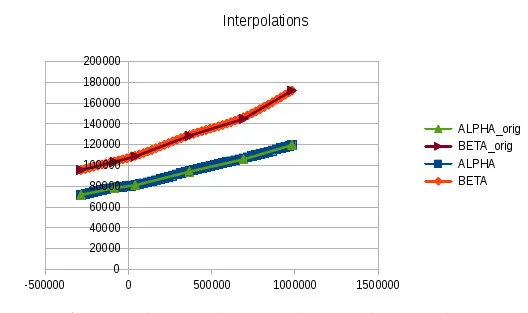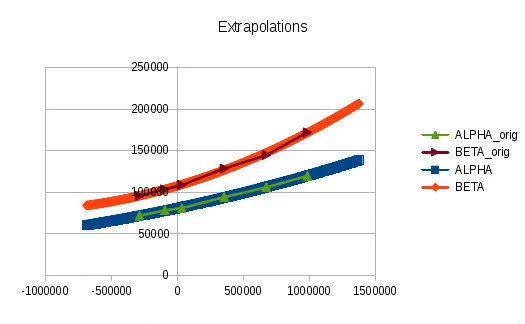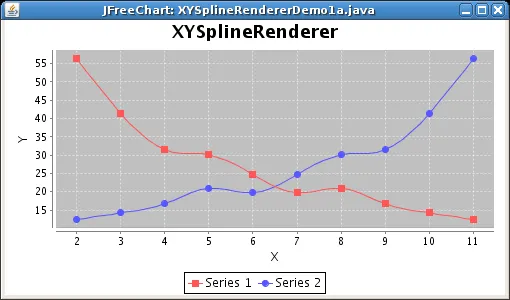Java曲线拟合库
20
- Russell Leggett
1
问题被“挂起”:可以重新措辞问题,以在Java中提供曲线拟合代码的示例(当然,该代码将引入一些库,因此可以将其视为建议)。这个问题不是关于JFreeChart的,它只是接收点并显示它们,但不会生成额外的点。我实际上很惊讶Linked和Related没有显示出那个问题。 - David Tonhofer
2个回答
10
Apache Commons Math 提供了一系列不错的算法,尤其是 "SplineInterpolator",详情请见 API 文档
以下是一个使用 Groovy 调用插值函数 alpha(x) 和 beta(x) 的示例:
package example.com
import org.apache.commons.math3.analysis.interpolation.SplineInterpolator
import org.apache.commons.math3.analysis.polynomials.PolynomialSplineFunction
import statec.Extrapolate.Value;
class Interpolate {
enum Value {
ALPHA, BETA
}
def static xValues = [
-284086,
-94784,
31446,
354837,
667782,
982191
]
def static alphaValues = [
71641,
78245,
80871,
94045,
105780,
119616
]
def static betaValues = [
95552,
103413,
108667,
128456,
144686,
171953
]
static def getValueByName(Value value, int i) {
def res
switch (value) {
case Value.ALPHA:
res = alphaValues[i]
break
case Value.BETA:
res = betaValues[i]
break
default:
assert false
}
return res
}
static PolynomialSplineFunction interpolate(Value value) {
def yValues = []
int i = 0
xValues.each {
def y = getValueByName(value, i++)
yValues << (y as Double)
}
SplineInterpolator spi = new SplineInterpolator()
return spi.interpolate(xValues as double[], yValues as double[])
}
static void main(def argv) {
//
// Create a map mapping a Value instance to its interpolating function
//
def interpolations = [:]
Value.values().each {
interpolations[it] = interpolate(it)
}
//
// Create an array of new x values to compute display.
// Make sure the last "original" value is in there!
// Note that the newxValues MUST stay within the range of the original xValues!
//
def newxValues = []
for (long x = xValues[0] ; x < xValues[-1] ; x+=25000) {
newxValues << x
}
newxValues << xValues[-1]
//
// Write interpolated values for ALPHA and BETA, adding the original values in columns 4 and 5
//
System.out << "X , ALPHA, BETA, X_orig, ALPHA_orig, BETA_orig" << "\n"
int origIndex = 0
newxValues.each { long x ->
def alpha_ipol = interpolations[Value.ALPHA].value(x)
def beta_ipol = interpolations[Value.BETA].value(x)
String out = "${x} , ${alpha_ipol} , ${beta_ipol}"
if (x >= xValues[origIndex]) {
out += ", ${xValues[origIndex]}, ${alphaValues[origIndex]}, ${betaValues[origIndex]}"
origIndex++
}
System.out << out << "\n"
}
}
}

现在举个与主题无关但很有趣的EXTRAPOLATIONS实例。这里我们使用与上面相同的数据,但是使用一个二次多项式进行外推。当然,还要选择适当的类。再次用Groovy语言编写:
package example.com
import org.apache.commons.math3.analysis.polynomials.PolynomialFunction
import org.apache.commons.math3.fitting.PolynomialFitter
import org.apache.commons.math3.fitting.WeightedObservedPoint
import org.apache.commons.math3.optim.SimpleVectorValueChecker
import org.apache.commons.math3.optim.nonlinear.vector.jacobian.GaussNewtonOptimizer
class Extrapolate {
enum Value {
ALPHA, BETA
}
def static xValues = [
-284086,
-94784,
31446,
354837,
667782,
982191
]
def static alphaValues = [
71641,
78245,
80871,
94045,
105780,
119616
]
def static betaValues = [
95552,
103413,
108667,
128456,
144686,
171953
]
static def getValueByName(Value value, int i) {
def res
switch (value) {
case Value.ALPHA:
res = alphaValues[i]
break
case Value.BETA:
res = betaValues[i]
break
default:
assert false
}
return res
}
static PolynomialFunction extrapolate(Value value) {
//
// how to check that we converged
//
def checker
A: {
double relativeThreshold = 0.01
double absoluteThreshold = 10
int maxIter = 1000
checker = new SimpleVectorValueChecker(relativeThreshold, absoluteThreshold, maxIter)
}
//
// how to fit
//
def fitter
B: {
def useLUdecomposition = true
def optimizer = new GaussNewtonOptimizer(useLUdecomposition, checker)
fitter = new PolynomialFitter(optimizer)
int i = 0
xValues.each {
def weight = 1.0
def y = getValueByName(value, i++)
fitter.addObservedPoint(new WeightedObservedPoint(weight, it, y))
}
}
//
// fit using a 2-degree polynomial; guess at a linear function at first
// "a0 + (a1 * x) + (a2 * x²)"; a linear guess mean a2 == 0
//
def params
C: {
def mStart = getValueByName(value,0)
def mEnd = getValueByName(value,-1)
def xStart = xValues[0]
def xEnd = xValues[-1]
def a2 = 0
def a1 = (mEnd - mStart) / (xEnd - xStart) // slope
def a0 = mStart - (xStart * a1) // 0-intersection
def guess = [a0 , a1 , a2]
params = fitter.fit(guess as double[])
}
//
// make polynomial
//
return new PolynomialFunction(params)
}
static void main(def argv) {
//
// Create a map mapping a Value instance to its interpolating function
//
def extrapolations = [:]
Value.values().each {
extrapolations[it] = extrapolate(it)
}
//
// New x, this times reaching out past the range of the original xValues
//
def newxValues = []
for (long x = xValues[0] - 400000L ; x < xValues[-1] + 400000L ; x += 10000) {
newxValues << x
}
//
// Write the extrapolated series ALPHA and BETA, adding the original values in columns 4 and 5
//
System.out << "X , ALPHA, BETA, X_orig, ALPHA_orig, BETA_orig" << "\n"
int origIndex = 0
newxValues.each { long x ->
def alpha_xpol = extrapolations[Value.ALPHA].value(x)
def beta_xpol = extrapolations[Value.BETA].value(x)
String out = "${x} , ${alpha_xpol} , ${beta_xpol}"
if (origIndex < xValues.size() && x >= xValues[origIndex]) {
out += ", ${xValues[origIndex]}, ${alphaValues[origIndex]}, ${betaValues[origIndex]}"
origIndex++
}
System.out << out << "\n"
}
}
}

- David Tonhofer
0
我从未这样做过,但快速的谷歌搜索显示Bezier曲线已经在http://java.sun.com/j2se/1.5.0/docs/api/java/awt/geom/QuadCurve2D.Double.html中实现。
然后,您可以从该曲线获取getPathIterator(),根据文档所说,您将获得“形状边界的坐标”,这可能是您要寻找的内容。
- jbasko
2
1不,他不想这样做。他需要使用样条插值或一些启发式方法计算曲线的控制点。 - Matej
我建议您最好阅读http://en.wikipedia.org/wiki/Spline_(mathematics)和http://en.wikipedia.org/wiki/B%C3%A9zier_curve。贝塞尔曲线是建模这些曲线的一种方式。通过拥有此曲线上点的坐标,他有效地获得了所需的内容。 - jbasko
网页内容由stack overflow 提供, 点击上面的可以查看英文原文,
原文链接
原文链接
